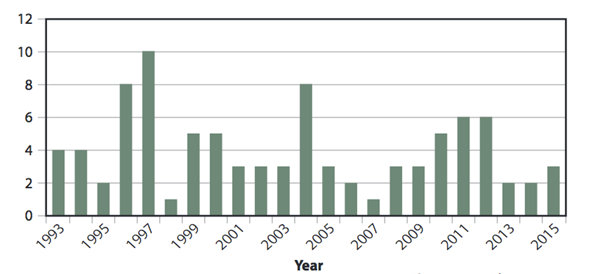
Tyzzer’s disease was originally described in mice in 1917, and since then has been diagnosed in multiple species of domestic animals and wildlife worldwide. Tyzzer’s disease is highly fatal in young foals, and is caused by the bacterium Clostridium piliforme. The organism is an intracellular pathogen that primarily infects the lower intestinal tract and can disseminate through the circulatory or lymphatic systems to visceral organs.
Clostridium piliforme can cause subclinical infections, but infections are commonly acute and fatal in foals. Foals are usually found comatose or dead, but clinical signs can include depression, anorexia, pyrexia, jaundice, diarrhea, and recumbency. Affected foals are typically between one to six weeks of age, but most cases occur between one and two weeks of age. The disease primarily affects the liver, causing necrotizing hepatitis.
Antemortem serology and fecal polymerase chain reaction (PCR) assays can be used to test for C. piliforme, however results must be interpreted in combination with appropriate clinical signs to make a presumptive clinical diagnosis. A definitive diagnosis is made upon postmortem examination and is accomplished by associating the organism with characteristic liver lesions; this association can be made by microscopically visualizing the organism or by detecting the organism’s genetic material by PCR. There is no known effective treatment for the disease, and vaccines are not available.
Over the last 23 years, 92 cases of Tyzzer’s disease have been diagnosed at the University of Kentucky Veterinary Diagnostic Laboratory (see accompanying chart). The disease was identified in 44 colts, 36 fillies and in 12 foals where the sex was not noted. Of the 92 cases diagnosed, there were 82 Thoroughbreds is consistent with the breed distribution typically seen from 7 to 270 days with an average age of 26 days. Fifteen foals were 30 days of age or older. Of the 92 cases, 89 died in the months of February through June. The other three cases occurred in January, July and October.
For more information contact author Dr. Jacqueline Smith, 859-257-8283, or email jsmit8@uky.edu at the University of Kentucky Veterinary Diagnostic Laboratory, Lexington, Kentucky.
This article is from the Equine Disease Quarterly, published by the University of Kentucky College of Agriculture, Food and Environment Department of Veterinary Science and sponsored by Lloyd’s of London and its Kentucky agents. You may subscribe to this publication for free.


